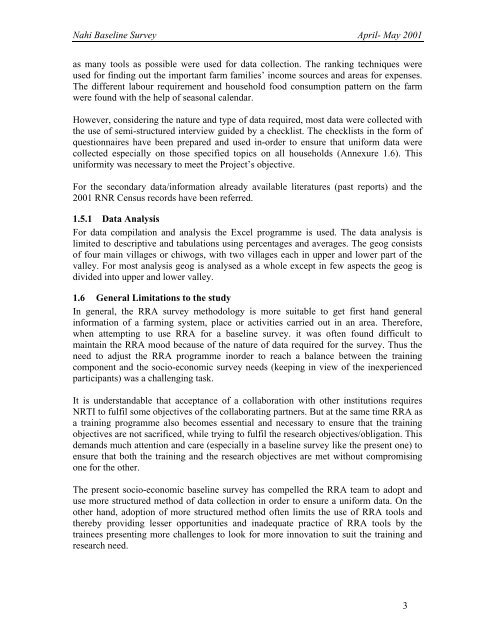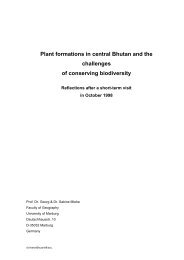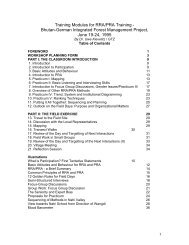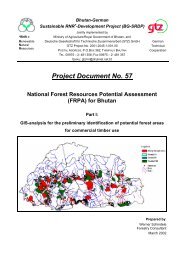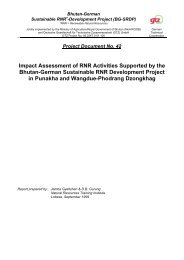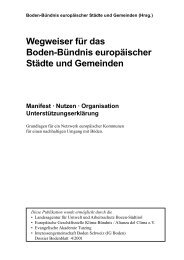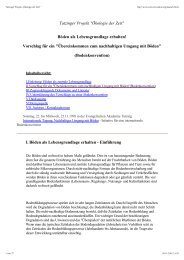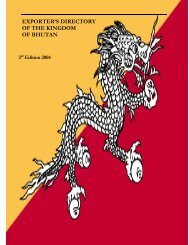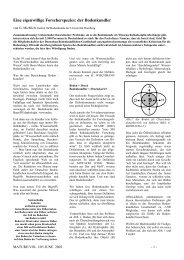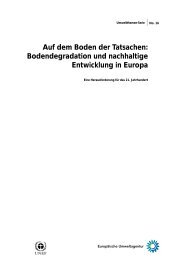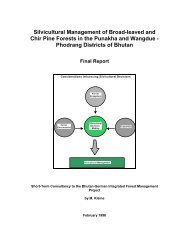GTZ Project Document No. 51 Report on Nahi Baseline Survey
GTZ Project Document No. 51 Report on Nahi Baseline Survey
GTZ Project Document No. 51 Report on Nahi Baseline Survey
Create successful ePaper yourself
Turn your PDF publications into a flip-book with our unique Google optimized e-Paper software.
<strong>Nahi</strong> <strong>Baseline</strong> <strong>Survey</strong> April- May 2001as many tools as possible were used for data collecti<strong>on</strong>. The ranking techniques wereused for finding out the important farm families’ income sources and areas for expenses.The different labour requirement and household food c<strong>on</strong>sumpti<strong>on</strong> pattern <strong>on</strong> the farmwere found with the help of seas<strong>on</strong>al calendar.However, c<strong>on</strong>sidering the nature and type of data required, most data were collected withthe use of semi-structured interview guided by a checklist. The checklists in the form ofquesti<strong>on</strong>naires have been prepared and used in-order to ensure that uniform data werecollected especially <strong>on</strong> those specified topics <strong>on</strong> all households (Annexure 1.6). Thisuniformity was necessary to meet the <str<strong>on</strong>g>Project</str<strong>on</strong>g>’s objective.For the sec<strong>on</strong>dary data/informati<strong>on</strong> already available literatures (past reports) and the2001 RNR Census records have been referred.1.5.1 Data AnalysisFor data compilati<strong>on</strong> and analysis the Excel programme is used. The data analysis islimited to descriptive and tabulati<strong>on</strong>s using percentages and averages. The geog c<strong>on</strong>sistsof four main villages or chiwogs, with two villages each in upper and lower part of thevalley. For most analysis geog is analysed as a whole except in few aspects the geog isdivided into upper and lower valley.1.6 General Limitati<strong>on</strong>s to the studyIn general, the RRA survey methodology is more suitable to get first hand generalinformati<strong>on</strong> of a farming system, place or activities carried out in an area. Therefore,when attempting to use RRA for a baseline survey. it was often found difficult tomaintain the RRA mood because of the nature of data required for the survey. Thus theneed to adjust the RRA programme inorder to reach a balance between the trainingcomp<strong>on</strong>ent and the socio-ec<strong>on</strong>omic survey needs (keeping in view of the inexperiencedparticipants) was a challenging task.It is understandable that acceptance of a collaborati<strong>on</strong> with other instituti<strong>on</strong>s requiresNRTI to fulfil some objectives of the collaborating partners. But at the same time RRA asa training programme also becomes essential and necessary to ensure that the trainingobjectives are not sacrificed, while trying to fulfil the research objectives/obligati<strong>on</strong>. Thisdemands much attenti<strong>on</strong> and care (especially in a baseline survey like the present <strong>on</strong>e) toensure that both the training and the research objectives are met without compromising<strong>on</strong>e for the other.The present socio-ec<strong>on</strong>omic baseline survey has compelled the RRA team to adopt anduse more structured method of data collecti<strong>on</strong> in order to ensure a uniform data. On theother hand, adopti<strong>on</strong> of more structured method often limits the use of RRA tools andthereby providing lesser opportunities and inadequate practice of RRA tools by thetrainees presenting more challenges to look for more innovati<strong>on</strong> to suit the training andresearch need.3


